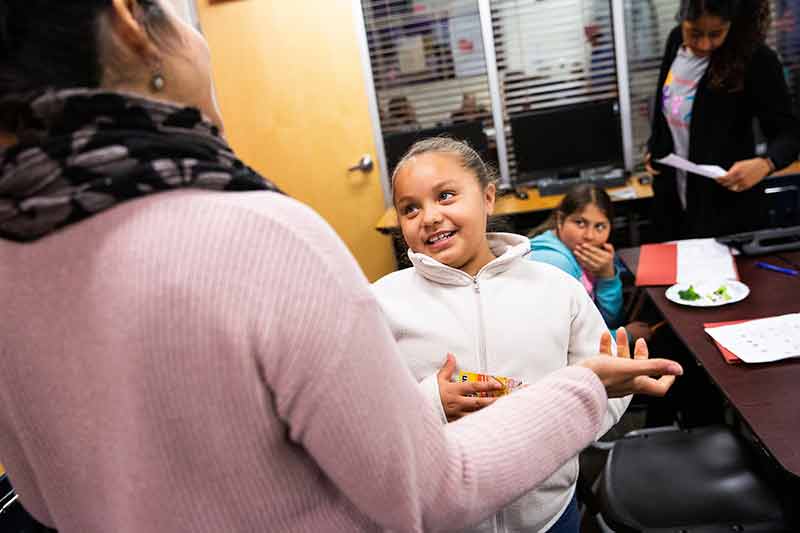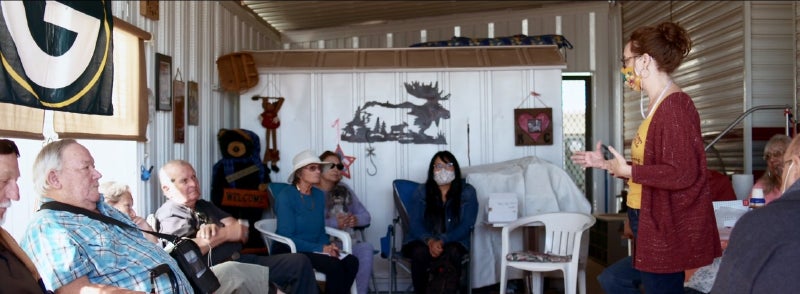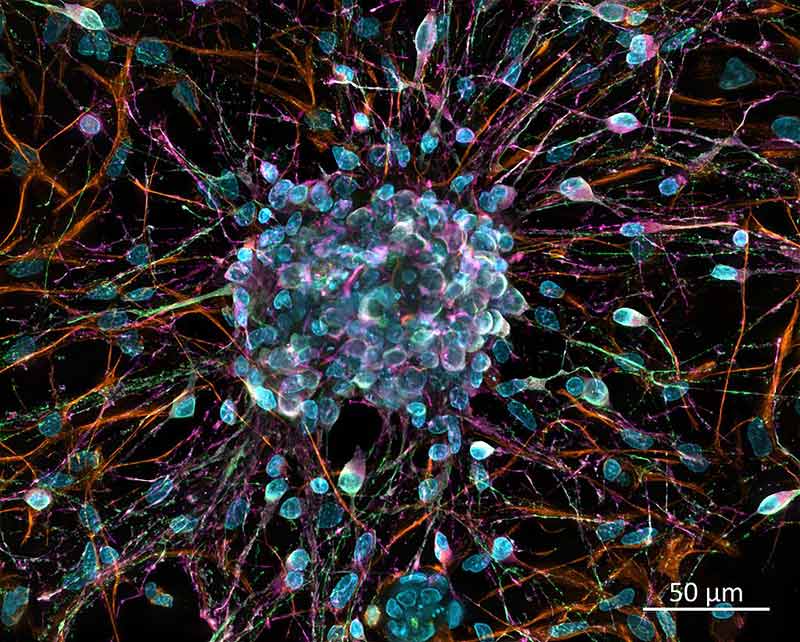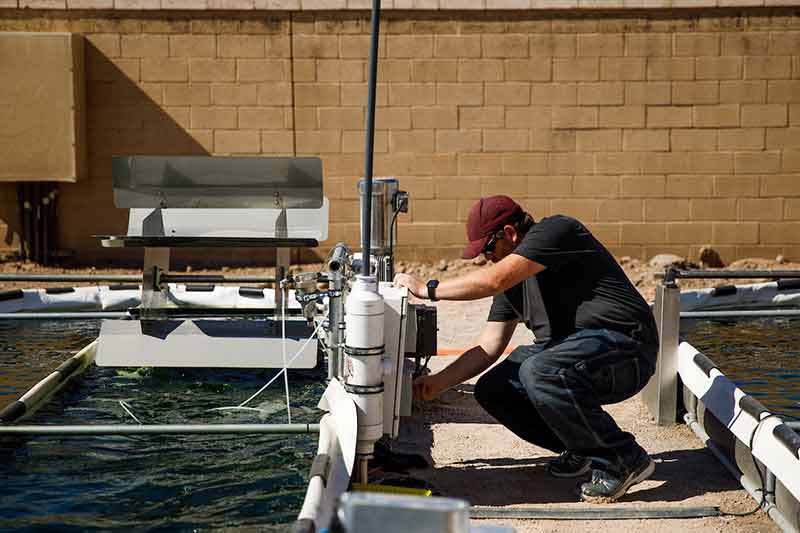Despite a year of unparalleled challenges, including a pandemic, travel restrictions and redirected funding, Arizona State University continues to grow its research enterprise and advance new discoveries and solutions.
In fiscal year 2020, the university remained in the top 10 for research expenditures among institutions without a medical school, ranking sixth, according to new data from the National Science Foundation Higher Education Research and Development rankings.
With $673.4 million in spending, ASU ranks No. 6 against 755 other institutions without a medical school, ahead of the California Institute of Technology and Carnegie Mellon University.
Among all U.S. public institutions, ASU ranks in the top 30, or 26th of 415, ahead of the University of Iowa, University of Colorado and University of Virginia.
Overall, ASU ranked in the top 5% of all universities with research expenditures, or 43rd out of 915 for all universities nationwide with or without a medical school, ahead of the University of Chicago, Brown University and Princeton University.
“Every day, ASU’s talented faculty, students and staff put their energy and intellect into solving the world’s most complex problems,” said Sally C. Morton, executive vice president of Knowledge Enterprise at ASU. “That work is evident in ASU’s continued position at the top of the nation’s research rankings, demonstrating not only the university’s research excellence, but the trust our communities place in ASU to help tackle the biggest challenges of our time.”
Many federal agencies increased their investments in ASU research in fiscal year 2020.
National Science Foundation expenditures rose into the top 20, increasing by 11% to position ASU at No. 17, ahead of the University of California, Berkeley; the University of California, Los Angeles; the University of Southern California; and Pennsylvania State University.
The university’s sponsored expenditures from the Department of Defense grew by 30% from fiscal year 2019, placing ASU in the top 30 (No. 30) nationally, ahead of Purdue University, Texas A&M University and Ohio State University.
Spending of health and human services funds also increased, putting ASU at No. 9 among institutions without a medical school, ahead of Princeton, Georgia Tech and Colorado.
ASU receives funding for research from federal agencies, state and local grants, businesses, and other private organizations, which is often awarded over multi-year periods. Research expenditures — the amount of this funding an institution spends in a particular year — provide the most effective way to measure and compare research enterprises. NSF’s yearly HERD survey collects and ranks research expenditure information from hundreds of institutions nationwide.
The following are just a few examples of how ASU is using research dollars to make a positive impact.
Culturally informed diabetes prevention
Instructor Maria Silva talks about healthy food choices with participants at the Watts Family Maryvale YMCA.
Approximately 10% of Americans have diabetes, which is the seventh leading cause of death in the U.S. But among Latinos, that number increases to 12.5%.
Can culturally grounded lifestyle interventions prevent Type 2 diabetes in prediabetic Latino youth? That’s the question Professor Gabriel Shaibi of the Edson College of Nursing and Health Innovation seeks to answer with his research.
His project, Preventing Diabetes in Latino Youth, was funded through the National Institutes of Health. Shaibi connected ASU researchers with local organizations to create a diabetes prevention program that addressed the unique social — as well as behavioral and biological — determinants that contribute to diabetes risk.
They finished collecting data from 117 youth with prediabetes and have observed reductions in diabetes risk markers and improvements in quality of life. These promising data informed the next phase of their research, which recently received $3.3 million in funding, to extend the program to high-risk Latino families and connect with additional community partners across the state.
“Latino children, families and communities experience significant health disparities related to Type 2 diabetes risk,” Shaibi said. “This work demonstrates the collective impact that can be made when partners come together to address complex issues such as diabetes disparities in underserved communities.”
Building resilient communities
KER Executive Director Patricia Solis speaks to a group of mobile home residents about heat resiliency issues. Photo courtesy of Knowledge Exchange for Resilience
The COVID-19 pandemic didn’t just cause health problems. It had a ripple effect through the economy, creating additional challenges like an eviction crisis.
When the pandemic hit Arizona, the Maricopa Association of Governments reached out to ASU’s Knowledge Exchange for Resilience (KER) for deeper understanding of the county’s housing needs. KER developed a dashboard to provide data visualizations of changes in local economic indicators and created simulation prediction models, which helped the county make evidence-based decisions on how to prevent a surge in evictions.
KER is led by ASU Vice Provost Elizabeth Wentz and was funded through the Virginia G. Piper Charitable Trust. It aims to bring the benefits of resilience to Maricopa County by advancing social cohesion, economic prosperity and environmental security. By engaging in local meetings, gathering with partners and actively listening to community needs, KER finds different ways to help Maricopa County identify vulnerabilities and respond to challenges.
“Engineers may think about the resilience of structures, and psychologists may think of it in terms of the individual,” said Executive Director Patricia Solis. “We take a community-level view that considers resilience in terms of our systems and how we as a society get through those big shocks like the pandemic or longer-term stress like urban heat.”
KER has also worked with the county on heat resilience, gathering data from 80 organizations trying to reduce heat-associated deaths and searching for countywide patterns of vulnerability.
WATCH: Learn how KER worked with communities to understand the urban heat problem
They found that people who live in mobile homes and manufactured homes were disproportionately at risk for heat-associated deaths. In May 2020, stakeholders turned the findings into action through a number of initiatives, including water delivery, study of utility aid eligibility, health surveys and working with ASU engineering students to improve shade in mobile home park designs.
Combination therapy for traumatic brain injury
Image of a cell culture of primary cortical neurons.
After a traumatic brain injury, or TBI, most of a patient’s care will involve managing symptoms like intercranial pressure, followed by physical or speech therapy later if the patient has any functional impairment. But Associate Professor Sarah Stabenfeldt from the School of Biological and Health Systems Engineering may be unlocking a new treatment option.
She and her collaborators in the school, Associate Professor Jeffrey Kleim and postdoctoral researcher Reed Bjorklund, looked at combining traditional motor rehabilitation with the transplantation of special cells called neural progenitors. These are immature cells that can become different types of neural cells. Both strategies had proved beneficial when used alone.
“Our preliminary study showed that if we combine these two approaches, you have not just an added effect, but a synergistic effect, in terms of the functionality after injury,” Stabenfeldt said. “Now we are asking, 'what is the underlying mechanism for this response?'”
Her team is working with Trent Anderson, an electrophysiology expert from the University of Arizona, to find out how and why this therapeutic combination works on a molecular level. One possibility is that the transplanted cells, directed through critical rehab signaling, differentiate into neuronal cells that may integrate into the brain’s neural network. Another possibility is that the cells and therapy together provide the key molecular signals to promote repair and neuroplasticity in the injured brain.
Their project, Regenerative Rehabilitation for Traumatic Brain Injury, was funded through the Arizona Biomedical Research Commission.
Sustainable wastewater treatment
Everett Eustance, an ASU assistant research scientist, leads the algae cultivation trial at Mesa's Northwest Water Reclamation Plant.
Treating wastewater produces carbon dioxide, which harms the environment. It’s a problem that will only continue to grow as urban populations rise. But Bruce Rittmann, Regents Professor in the School of Sustainable Engineering and the Built Environment and director of the Biodesign Swette Center for Environmental Biotechnology, sees a win-win opportunity.
Rittmann works with microalgae — single-celled, microscopic organisms — which consume carbon dioxide and can be converted into biofuel and other useful materials. His team partnered with the city of Mesa to test the real-world feasibility of using microalgae to clean up the carbon dioxide from the Northwest Water Reclamation Plant. Their project, Membrane Carbonation for 100% Efficient Delivery of Industrial CO2 Gases, was funded through the U.S. Department of Energy.
The plant captured carbon dioxide created during the water treatment process and sent some of it to nearby algae ponds, where microalgae used it for photosynthesis. After evaluating the results of this trial, the ASU team hopes to conduct another, where they will add a waste stream from the plant into the algae ponds to provide nutrients for the algae. This would create a truly closed system where all the plant’s waste products are used.
“It would be the whole shebang. We’d be getting our nutrients from the wastewater and the CO2 to feed the microalgae,” said Justin Flory, an associate director of research in ASU’s Center for Negative Carbon Emissions and project manager of the initial trial.
Unwavering commitment
ASU achieved top rankings in many other national categories.
• No. 1 (of 253) in anthropology for the fifth year in a row, ahead of University of Michigan, Harvard University and Stanford University.
• No. 1 (of 362) in geological and earth sciences, ahead of Massachusetts Institute of Technology, Pennsylvania State University and the University of Arizona.
• No. 1 (of 252) in transdisciplinary, multidisciplinary and other sciences, ahead of Northwestern University, University of Pittsburgh and Johns Hopkins University.
• No. 3 (of 501) in social sciences, ahead of Cornell University; University of California, Los Angeles; and University of North Carolina, Chapel Hill.
• No. 8 (of 555) in non-science and engineering disciplines, ahead of University of Kansas, Georgia State University and Syracuse University. Subdisciplines in this category all fell within the nation’s top 20 and include business management and business administration at No. 4; communications and communications technologies at No. 8; education at No. 9; visual and performing arts at No. 12; humanities at No. 14; law at No. 14; and social work at No. 18.
• No. 10 (of 269) in civil engineering, ahead of Duke University, University of Illinois at Urbana-Champaign and Clemson University.
• No. 11 (of 295) in electrical, electronic and communications engineering, ahead of Stanford University, Purdue University and University of Washington.
• No. 18 (of 415) in engineering overall, ahead of Cornell University, California Institute of Technology and Rutgers University.
• No. 18 (of 442) in psychology, ahead of University of Illinois at Urbana-Champaign, Vanderbilt University and University of Oregon.
“Research universities have a crucial role to play in maintaining and improving the economic, social, cultural and overall health of our society,” Morton said. “ASU’s unwavering commitment to the communities we serve guides the work we do each day to improve lives.”
More Science and technology

Stuck at the airport and we love it #not
Airports don’t bring out the best in people.Ten years ago, Ashwin Rajadesingan was traveling and had that thought. Today, he is an assistant professor at the University of Texas at Austin, but back…

ASU in position to accelerate collaboration between space, semiconductor industries
More than 200 academic, business and government leaders in the space industry converged in Tempe March 19–20 for the third annual Arizona Space Summit, a statewide effort designed to elevate…

A spectacular celestial event: Nova explosion in Northern Crown constellation expected within 18 months
Within the next year to 18 months, stargazers around the world will witness a dazzling celestial event as a “new” star appears in the constellation Corona Borealis, also known as the Northern Crown.…









